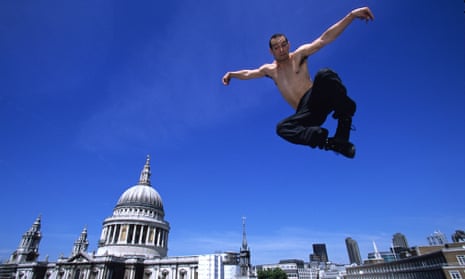A rising number of daredevil stunts such as scaling skyscrapers and parachuting from tall structures is being fuelled by competition for online acclaim, according to “urban explorers”, who warn more people are dying as a result.
The immense popularity of online videos of people climbing the world’s tallest buildings, including the London Shard, had turned urban exploration, which traditionally involves surreptitiously exploring the off-limits corners of towns and cities, into an extreme sport, said academics from Southampton and Greenwich universities.
Their comments come after a court barred four men from scaling structures in England and Wales after they posted online photographs and videos of themselves hanging 15 storeys above ground from a building in Lowestoft; climbing a crane in the town centre; and parachuting from a wind turbine.
A Suffolk police spokesman said officers had no alternative but to take action as they could have fallen and not only killed themselves but passersby. “Evidence gathered by police showed they had repeatedly carried out the activity and had been posting footage on the internet,” he added.
Dr Bradley Garrett, a cultural geographer at Southampton University, said the case illustrated how a younger generation of “urbex” enthusiasts compete for attention and credibility online by combining their adventures with riskier activities such as base jumping, where people parachute from structures, and parkour, which involves navigating urban spaces by climbing, jumping, balancing and running through buildings.
Garrett, who penetrated London’s secret underground tunnels and scaled the Shard while researching his PhD on urban explorers, said: “The community has changed drastically. A lot of these kids are putting themselves at greater risk to gain credibility on social media channels. There have been an increased number of deaths in the urban exploration community worldwide in the pastfew years and that’s gone hand in hand with the increased desire to publish these exploits on social media.”
His views are shared by Theo Kindynis, doctoral candidate at the University of Greenwich, said: “If you look at what these kids [in Lowestoft] were actually doing it’s this new offshoot of urban exploration which seems to be all about internet fame and making a name for themselves. The problem with these guys is not only was what they were doing so reckless they were publicising it flagrantly online.”
Kindynis said these riskier practices had been popularised in recent years by viral videos of climbers such as the Russian duo Vadim Makhorov and Vitality Rasklov, known as On The Roofs, and British “professional adventurer” James Kingston. These typically showed them scaling an under-construction skyscraper, tower or crane before dangling their legs or hanging their entire bodies, without safety equipment, from a concrete or steel precipice, he added.
One of On The Roof’s videos, which shows them ascending the 632-metre-high (2,073 ft) Shanghai Tower, then high-fiving one another while balancing on a crane arm, has more than 50m views on YouTube.
Matthew Adams, one of the four urban explorers found guilty at Lowestoft magistrates court last week of causing alarm and distress to residents, said social media had pushed people more into “the stunts and hanging while climbing rather than just photographing the views” while exploring.
Adams, who publishes photographs and videos of his climbs on his Facebook page, Unexposed Explorations, said social media was “a massive part” of his practice but denied this was his sole motivation. “That might look like I’m just doing it for attention but I consider myself an artist,” said Adams, who studied art and photography at Lowestoft College.
Adams, 23, Daniel Batchelor, 26, and a 17-year-old boy, who cannot be named for legal reasons, all from Lowestoft, along with Javier Centeno-Gomez, 24, from Ellough, were given criminal behaviour orders banning them from climbing manmade structures. The order also prevents them going beyond safety barriers on any building and bans them from parachuting off any structure without permission from the owner.
Adams said: “It’s quite over the top for a first offence and when you’re pleading guilty. We were [at St Peter’s Court building in Lowestoft] for three hours uninterrupted by anyone, so no one could have felt that alarmed or distressed.”
Bradley Garrett, who last year received a conditional discharge for conspiring to commit criminal damage during sorties into disused London Underground tunnels and stations such as Aldwych, condemned the penalty imposed on Adams and his friends, warning it would provoke riskier behaviour rather than act as a deterrent.
“The community will be much more militant … if we start clamping down,” he said. “I guarantee that locks will start coming off, windows will be broken. The only result of these convictions is going to be an escalation of tension between people who are undertaking subversive practices in the city and authorities.”
